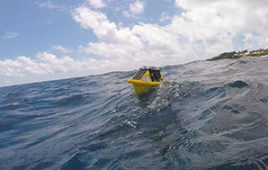OU and ConocoPhillips join forces on industry-wide biocorrosion challenge
The University of Oklahoma has joined forces with the Upstream Drilling and Production section of ConocoPhillips to ensure our nation’s energy infrastructure is robust with the creation of a new Biocorrosion Center within the OU Institute for Energy and Environment.
Larry R. Grillot, dean of the Mewbourne College of Earth and Energy, says the collaboration with ConocoPhillips in this area demonstrates OU’s continuing commitment to work closely with industry to address a broad range of energy issues through multidisciplinary studies.
The Center will give OU researchers an opportunity to work closely with ConocoPhillips to develop new technologies to manage biocorrosion in the nation’s pipelines, storage facilities, separators, tankers and refineries.
ConocoPhillips will provide start-up funding for the Center, but other major oil companies and entities will be invited to participate in the financial support of these efforts. Center researchers will explore the fundamental scientific issues that lead to new knowledge, understanding and technology for the diagnosis, mitigation and prevention of biocorrosion problems and fuel biodeterioration.
Joseph Suflita, Center director, says he is pleased to collaborate with ConocoPhillips to bring the talents of OU to bear on the relatively poorly understood but critically important issue of biocorrosion in the oil and gas sector.
One of the leading causes of hazardous material discharges to the environment is the corrosive failure of energy equipment. This is the same infrastructure relied on for the transport of next generation fuels. Suflita says, “We must explore ways to maintain the integrity of equipment and prevent environmental releases in the first place.”
Gary Jenneman, corrosion management supervisor at ConocoPhillips, says that the collaboration with OU is unique. “While there are many corrosion centers around the world, there are few that specifically focus on the role of microorganisms in corrosion processes and none that have as much expertise in the study of anaerobic microorganisms.”
In the United States, a network of over 500,000 miles of pipeline crisscrossing the country carries 75 percent of the nation’s crude oil and 60 percent of refined petroleum products. Energy companies have sophisticated integrity management programs to maintain their equipment, initiate mitigation efforts and minimize the potential for product releases. Still, biocorrosion can result in through wall perforations, product interruptions and severe economic consequences.
The energy industry is faced with increasing environmental and regulatory pressures to integrate new fuels and new fuel combinations into their fuel stream. Newer fuel blends tend to be more susceptible to microbial decay compromising performance in a number of ways, including the biodeterioration of fuel quality and biocorrosion in downstream facilities.
Anaerobic microorganisms often catalyze biocorrosion processes but are poorly understood and difficult to control. OU is uniquely positioned to address these problems with a greater concentration of anaerobic microbiologists than anywhere in the western hemisphere.
Iwona Beech, an expert in metal corrosion microbiology, recently joined OU to collaborate on this and other projects. Beech brings unprecedented strength and decades of research on the fundamental aspects of anaerobic hydrocarbon metabolism and biocorrosion and allows OU investigators to take a leading role on this new initiative.
OU will collaborate with numerous scientists with expertise in this area, including Brenda Little, U.S. Navy, an authority in assessing corrosion electrochemistry. OU plans to integrate this discipline with microbiology to gain increased insight into the stability of metals used throughout the fuel infrastructure.
Suflita says he looks forward to working with ConocoPhillips and other energy companies to support the long-term goal of developing new technology solutions for the biocorrosion challenges facing the oil and gas industry. For more information about the OU Biocorrosion Center, contact Dr. Joseph Suflita, 405-325-5761.




